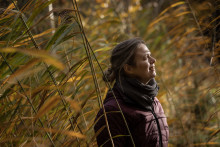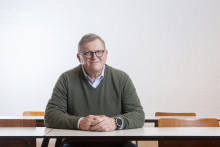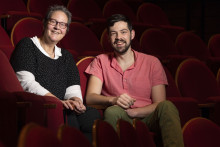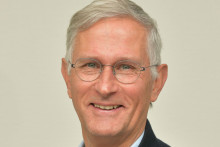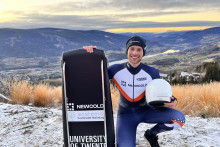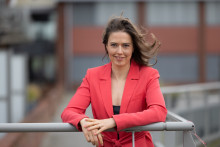- EN
- NL
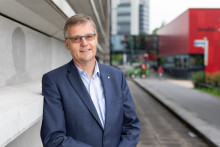 Spotlight
Spotlight‘Niet afdwingen, wel richting geven’
Met onder meer een UT-brede visie op het onderwijs en een nieuw talentbeleid in de steigers, vallen steeds meer puzzelstukjes op hun plek voor rector Tom Veldkamp. Aan de start van 2023 blikt hij vooruit op de bewegingen die de universiteit dit jaar inzet. ‘Gaat de werkdruk omlaag, dan doen we het goed.’
- EN
- NL
 Spotlight
Spotlight‘I don’t want to impose, I want to provide guidance’
With a UT-wide vision on education and a new talent development policy in the works, more and more pieces of the puzzle are falling into place for Rector Magnificus Tom Veldkamp. At the start of 2023 he looks ahead to the developments the university will go through in the coming year. ‘If the workload decreases, it means we are doing well.'
- EN
- NL
 Spotlight
SpotlightUT-alumnus Van de Rijdt ‘danst mee’ bij Mosa Meat
De loopbaan van UT-alumnus Tim van de Rijdt (40) is allesbehalve dertien in een dozijn. Na Newcom en Google werkt hij inmiddels als chief marketing officer bij kweekvleesbedrijf Mosa Meat. ‘We gokken niet op een massale gedragsverandering van de consument, daarom kweken we vlees.’
- EN
- NL
 Spotlight
SpotlightUT alumnus Van de Rijdt ‘dances along’ at Mosa Meat
The career of UT alumnus Tim van de Rijdt (40) is anything but run-of-the-mill. After working for Newcom and Google, he is now Chief Marketing Officer at cultured meat company Mosa Meat. ‘We’re not counting on any mass consumer behaviour change; that’s why we cultivate meat.’
- EN
- NL
 Spotlight
SpotlightTopsport combineren met studie, lukt dat? Drie UT'ers aan het woord
Ze studeren op de UT en werken daarnaast keihard om ook als topsporter te kunnen excelleren. De UT telt jaarlijks gemiddeld veertig studenten en medewerkers met een topsportstatus. Wat brengt die status hen? Een zweefvlieger, een topzeilster en een voetbalster van FC Twente aan het woord over hun grote passie.
- EN
- NL
 Spotlight
SpotlightCombining top sport with studies, is it possible? Three UT athletes share their views
In addition to their studies at the UT, they put in lots of hard work to excel as top athletes. Every year, the UT has an average of forty students and staff with a status as top-level athletes. What benefits does this status offer them? Below, a glider pilot, a top sailor and an FC Twente football player talk about their great passion.
- EN
- NL
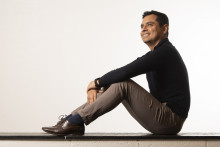 PhD stories
PhD stories‘I enjoy activism very much. Maybe too much’
Students or researchers? PhD candidates fall into a category of their own. What is it like to navigate the sometimes lonely road towards a doctoral degree? In this series, we put young academics of the University of Twente in the spotlight. This episode gives the stage to Roberto Cruz Martinez, an Information Specialist, a University Council member and PhD candidate at the UT.
- EN
- NL
 PhD stories
PhD stories‘Ik reik mensen graag de hand’
Zijn het studenten of onderzoekers? Promovendi vormen zo hun eigen categorie. Hoe is het om de soms eenzame weg naar een doctorsgraad te bewandelen? In deze reeks zetten we de jonge onderzoekers van de Universiteit Twente in de schijnwerpers. Aan het woord is Roberto Cruz Martinez, informatiespecialist, universiteitsraadslid en promovendus aan de UT.
- EN
- NL
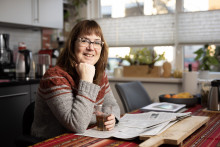 Spotlight
Spotlight‘Ik mis de studenten, de artiesten en de reuring in de Vrijhof’
Voor veel UT’ers ontwaakte de wereld begin 2022, toen we en masse uit de coronaperiode stapten. Voor Tineke Grootenboer (55), coördinator podiumkunst Cultuur, voelt het nog steeds 2020. Bij haar is begin dit jaar kanker geconstateerd. Ze ziet de campus maar sporadisch en vreest dat het einde van haar UT-tijd na ruim 25 jaar in zicht komt. ‘Normaal vlieg ik door die zaal om alles te regelen, nu zit ik daar in mijn rolstoel.’
- EN
- NL
 Spotlight
Spotlight‘I miss the students, the artists and the commotion in the Vrijhof’
For many members of the UT community, the world awoke back in 2022, when we returned from a period dominated by corona at a high pace. For Tineke Grootenboer (55), coordinator performing arts Culture, it still feels like 2020. At the start of this year, she was diagnosed with cancer. Now, she only visits the campus sporadically and fears that the end of her UT tenure is inching closer after more than 25 years. ‘Normally I fly down that hall to arrange everything, now I’m simply sitting here in my wheelchair.’
- EN
- NL
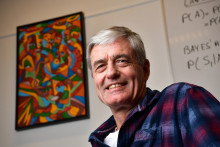 Spotlight
Spotlight‘In de basis is de UT nog altijd een leuke universiteit’
Na zesendertig jaar neemt wiskundedocent Dick Meijer (66) deze week afscheid van de UT. Als Uraadslid was hij jarenlang de luis in de pels van menig universiteitsbestuurder. ‘Het kritisch vermogen van de UT heb ik nooit hoog aangeslagen, daarom probeerde ik dat geluid te vertolken.’
- EN
- NL
 Spotlight
Spotlight‘At its core, the UT is still a great university’
After thirty-six years at the UT, mathematics lecturer Dick Meijer (66) bids the university farewell this week. As a member of the University Council, he has been a thorn in the side of many a university board member over the years. ‘I never thought highly of the UT’s critical capacity, so I tried to be that voice of criticism myself.’
